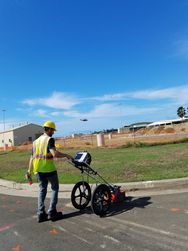3 Benefits of Scheduling GPR Before You Build

GPR, or ground penetrating radar, uses small pulses of energy to scan inside solid materials like concrete or soil. By timing how long it takes for the signal to bounce back and measuring the reflected signal strength, an integrated computer produces a 2D or 3D map of the inside of the material being scanned. Before you start laying the foundations for a construction project or remodeling a commercial building, you should schedule GPR scanning to get the following information.
Why Use GPR?
1. Identify Obstacles
Depending on where you're building, there could be anything from large pipes and discarded metal to utility lines running under your site. GPR scanning can locate these objects to within a quarter of an inch. This allows you to choose the best site for digging your foundation and avoid hitting buried objects. You'll prevent damage to equipment and utility lines.
 2. Locate Voids
2. Locate Voids
There are sometimes open areas underground due to natural caves, previous construction, and shifting geological features. GPR can identify empty space, so you can avoid letting equipment, supplies, or people fall into a collapsing void and instead look for a safe way to fill it.
3. Identify Materials & Density
Even if there isn't an open space underneath your construction site, there might be pockets of sandy, weak soil or partially eroded areas. These can shift and may not be suitable for holding up a structure. GPR technology can read the density of the soil underneath your construction site and warn you of any areas different from their surroundings.
If you need to schedule GPR in Honolulu and surrounding areas, contact Haggith’s Structural Scan & Inspection in Kaneohe, HI. Serving the island of Oahu, they use state-of-the-art equipment for non-destructive structural scans and are certified in the Theory and Practice of Applying Subsurface Interface Radar in Engineering and Geophysical Investigations. Call (808) 239-4330 or visit their website to learn more about their capabilities.
About the Business
Have a question? Ask the experts!
Send your question

